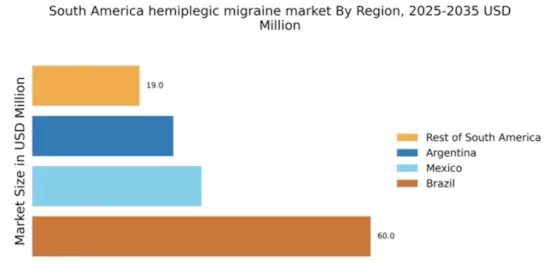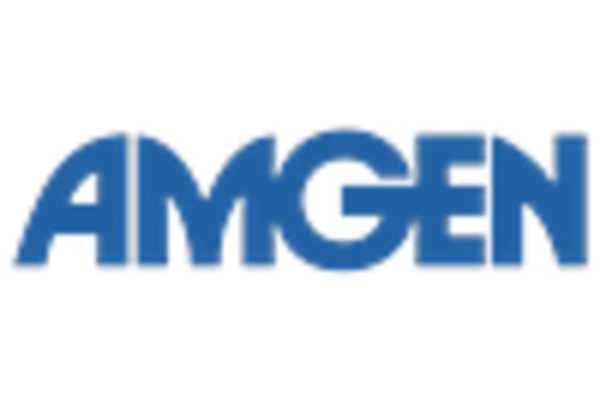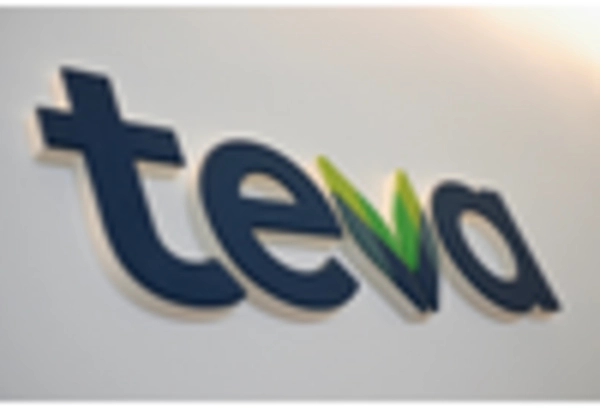Increased Healthcare Expenditure
Increased healthcare expenditure in South America is a significant driver for the hemiplegic migraine market. Governments and private sectors are investing more in healthcare infrastructure, which is likely to enhance access to medical services for patients suffering from hemiplegic migraine. Reports indicate that healthcare spending in the region has been rising at an annual rate of approximately 5% to 7%. This increase in expenditure is expected to facilitate better diagnostic tools and treatment options, ultimately benefiting patients. As healthcare systems improve, the likelihood of early diagnosis and effective management of hemiplegic migraine increases, which could lead to a larger patient population seeking treatment. Consequently, the upward trend in healthcare expenditure is poised to positively influence the market dynamics.
Advancements in Treatment Options
Advancements in treatment options for hemiplegic migraine are significantly influencing the hemiplegic migraine market in South America. The development of novel therapies, including targeted medications and biologics, has the potential to improve patient outcomes. Recent data suggests that the market for migraine treatments is projected to reach approximately $3 billion by 2026 in South America, driven by these advancements. Additionally, the introduction of personalized medicine approaches may enhance treatment efficacy, catering to the unique needs of patients. As healthcare providers adopt these innovative therapies, the market is likely to experience substantial growth. The ongoing research and development efforts in the region are expected to further expand the range of available treatment options, thereby positively impacting the hemiplegic migraine market.
Rising Incidence of Hemiplegic Migraine
The rising incidence of hemiplegic migraine in South America is a crucial driver for the hemiplegic migraine market. Recent studies indicate that the prevalence of this condition is increasing, with estimates suggesting that it affects approximately 0.1% to 0.5% of the population. This growing incidence is likely to lead to heightened demand for effective treatment options and healthcare services. As awareness of hemiplegic migraine increases, more patients are seeking medical attention, which could potentially drive market growth. Furthermore, the healthcare infrastructure in South America is gradually improving, allowing for better diagnosis and management of this condition. Consequently, the rising incidence of hemiplegic migraine is expected to significantly impact the market dynamics in the region.
Growing Patient Advocacy and Support Groups
The emergence of patient advocacy and support groups in South America is playing a pivotal role in shaping the hemiplegic migraine market. These organizations are dedicated to raising awareness about hemiplegic migraine, providing education, and supporting patients and their families. Their efforts are likely to lead to increased recognition of the condition, encouraging more individuals to seek medical help. Furthermore, these groups often collaborate with healthcare professionals to promote research and development initiatives, which could enhance treatment options available in the market. As patient advocacy continues to grow, it may foster a more informed patient population, ultimately driving demand for effective therapies and services in the hemiplegic migraine market.
Regulatory Support for Innovative Therapies
Regulatory support for innovative therapies is emerging as a key driver in the hemiplegic migraine market in South America. Regulatory bodies are increasingly recognizing the need for expedited approval processes for new treatments, particularly those that demonstrate significant efficacy in managing hemiplegic migraine. This supportive regulatory environment may encourage pharmaceutical companies to invest in research and development, leading to the introduction of novel therapies. As a result, the market could witness a surge in innovative treatment options, catering to the diverse needs of patients. The potential for faster access to new therapies may enhance patient outcomes and satisfaction, thereby positively impacting the overall market landscape.


















Leave a Comment